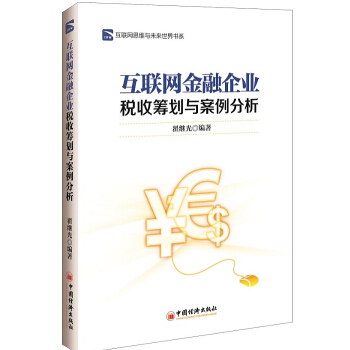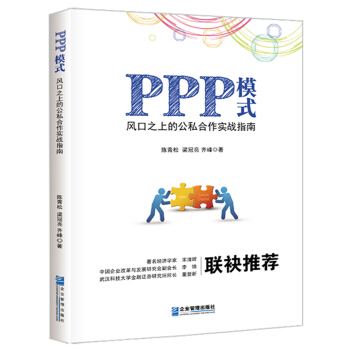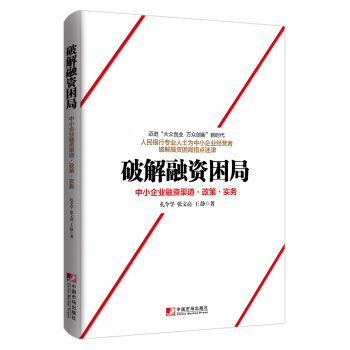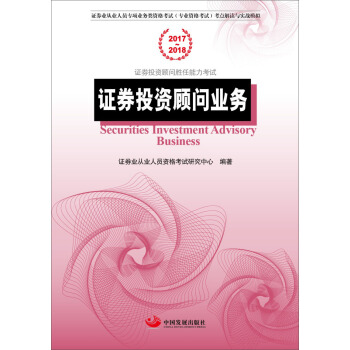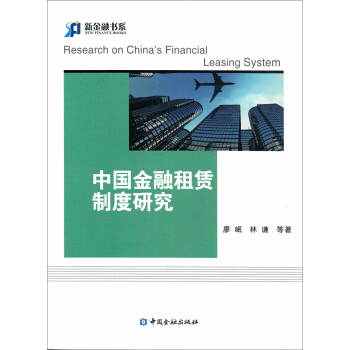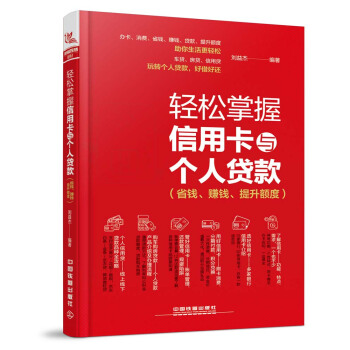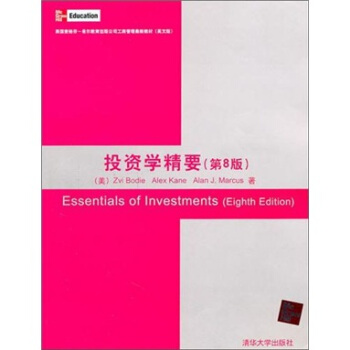

具体描述
內容簡介
《投資學精要(第8版)(英文版)》由美國三位著名的金融學教授博迪、凱恩、馬庫斯撰寫,是美國商學院和管理學院的教材,在世界各國都有很大的影響,被廣泛采用。本書詳細講解瞭投資領域中的風險組織理論、資本資産定價模型、套利定價理論、市場有效性、證券評估、衍生證券等重要內容。本書闡述詳盡,結構清楚,設計獨特,語言生動活潑,學生易於理解,內容上注重理論與實踐的結閤。
《投資學精要(第8版)(英文版)》適閤作為金融專業高年級本科生、研究生、MBA教材,也可供金融領域的研究人員,從業人員參考。
目錄
第1部分 投資要素第1章 投資:背景與要點
第2章 資産類彆與金融工具
第3章 證券市場
第4章 共同基金和其他投資公司
第2部分 投資組閤理論
第5章 風險與迴報:曆史與序幕
第6章 有效的分散化
第7章 資本資産定價模型與套利定價理論
第8章 有效市場假說
第9章 行為金融與技術分析
第3部分 債務證券
第10章 債券的價格與收益
第11章 債券資産組閤的管理
第4部分 證券分析
第12章 宏觀經濟分析與行業分析
第13章 股權估價
第14章 財務報錶分析
第5部分 衍生市場
第15章 期權市場
第16章 期權定價
第17章 期貨市場與風險管理
第6部分 積極的資産組閤管理
第19章 全球化與國際投資
第21章 稅收、通貨膨脹與投資戰略
附錄A
附錄B
精彩書摘
2.2 The Bond MarketThe bond market is composed of longer-term borrowing or debt instruments than those that trade in the money market. This market includes Treasury notes and bonds, corporate bonds, municipal bonds, mortgage securities, and federal agency debt.
These instruments are sometimes said to comprise the fixed-income capital market,because most of them promise either a fixed stream of income or stream of income that is determined according to a specified formula. In practice, these formulas can result in a flow of income that is far from fixed. Therefore, the term “fixed income” is probably not fully appropriate. It is simpler and more straightforward to call these securities either debt instruments or bonds.
Treasurv Notes and Bonds
The U.S. government borrows funds in large part by selling Treasury notes and bonds. T-notes are issued with original maturities ranging up to 10 years, while T-bonds are issued with maturities ranging from 10 to 30 years. Both bonds and notes may be issued in increments of $100, but far more commonly trade in denominations of $1,000. Both bonds and notes make semiannual interest payments called coupon payments, so named because in precomputer days, investors would literally clip a coupon attached to the bond and present it to receive the interest payment.
Figure 2.4 is an excerpt from a listing of Treasury issues in The Wall Street Journal Online.The highlighted bond matures in February 2015. The coupon income or interest paid by the bond is 4% of par value, meaning that for a $1,000 face value bond, $40 in annual interest payments will be made in two semi annulments of $20 each. The numbers to the right of the colon in the bid and ask prices represent units of 1/32 of a point.
The bid price of the highlighted bond is 105 20/32, or 105.625. The asked price is 105 22/32, or 105.6875. Although bonds are typically traded in denominations of $1,000 par value, the prices are quoted as a percentage of par value. Thus, the asked price of 105.6875 should be interpreted as 105.6875% of par or $1,056.875 for the $1,000 par value bond. Similarly, the bond could be sold to a dealer for $1,056.25. The +29 change means the closing price on this day rose 29/32 (as a percentage of par value) from the previous day's closing price. Finally, the yield to maturity on the bond based on the ask price is 3.017%.
The yield to maturity reported in the last column is a measure of the annualized rate of return to an investor who buys the bond and holds it until maturity.lt accounts for both coupon income as well as the difference between the purchase price of the bond and its final value of $1,000 at maturity. We discuss the yield to maturity in detail in Chapter 10.
Inffation-Protected Treasurv Bonds
The best place to start building an investment portfolio is at the least risky end of the spectrum. Around the world, governments of many countries,including the U.S., have issued bonds that are linked to an index of the cost of living in order to provide their citizens with an effective way to hedge inflation risk.
In the United States, inflation-protected Treasury bonds are called TIPS (Treasury Inflation Protected Securities). The principal amount on these bonds is adjusted in proportion to increases in the Consumer Price Index. Therefore, they provide a constant stream of income in real (inflation-adjusted) dollars, and the realinterest rates you eam on these securities are risk-free if you hold them to maturity. An i following the bond's maturity date in Figure 2.4 denotes that the bond is an inflation-indexed TIPS bond, and you will see that the reponed yields on these bonds are lowef than those on surrounding conventional Treasuries. Compare, for example, the reported yield on the January 2015i bond, 1.820%, to the 3.017% yield on the February 2015 bond that precedes it. The yields on TIPS bonds should be inter- preted as real or inflation-adjusted interest rates. We return to TIPS bonds in more detail in Chapter 10.
Federal Agency Debt
Some govemment agencies issue their own securities to finance their activities. These agencies usually are formed for public policy reasons to channel credit to a particular sector of the economy that Congress believes is not receiving adequate credit through normal private sources.
The major mortgage-related agencies are the Federal Home Loan Bank (FHLB), the Federal National Mortgage Association (FNMA, or Fannie Mae), the Government National Mortgage Association (GNMA, or Ginnie Mae), and the Federal Home Loan Mortgage Corporation
(FHLMC, or Freddie Mac).
Although the debt of federal agencies is not explicitly insured by the federal government, it has long been assumed that the government would assist an agency nearing default. Those beliefs were validated when Fannie Mae and Freddie Mac actually encountered severe financial distress in September 2008. With both firms on the brink of insolvency, the government stepped in and put them both into conservatorship, assigned the Federal Housing Finance Agency to run the firms, but did in fact agree to make good on the firm's bonds. (Turn back to Chapter 1 for more discussion of the Fannie and Freddie failures.)
International Bonds
Many firms borrow abroad and many investors buy bonds from foreign issuers. In addition to national capital markets, there is a thriving international capital market, largely centered in London.
A Eurobond is a bond denominated in a currency other than that of the country in which it is issued. For example, a dollar-denominated bond sold in Britain would be called a Euro-dollar bond. Similarly, investors might speak of Euroyen bonds, yen-denominated bonds sold outside Japan. Since the new European currency is called the euro, the term Eurobond may be confusing. It is best to think of them simply as international bonds.
In contrast to bonds that are issued in foreign currencies, many firms issue bonds in foreign countries but in the currency of the investor. For example, a Yankee bond is a dollar-denominated bond sold in the U.S. by a non-U.S. issuer. Similarly, Samurai bonds are yen-denominated bonds sold in Japan by non-Japanese issuers.
Municipal Bonds
Municipal bonds (“mums”) are issued by state and local governments. They are similar to Treasury and corporate bonds, except their interest income is exempt from federal income taxation. The interest income also is exempt from state and local taxation in the issuing state. Capital gains taxes, however, must be paid on mums if the bonds mature or are sold for more than the investor's purchase price.
There are basically two types of murucipal bonds. General obligation bonds are backed by the “full faith and credit” (i.e., the taxing power) of the issuer, while revenue bonds are issued to finance particular projects and are backed either by the revenues from that project or by the municipal agency operating the project. Typicalissuers of revenue bonds are airports, hospitals, and tumpike or port authorities. Revenue bonds are riskier in terms of default than general obligation bonds.
An industrial development bond is a revenue bond that is issued to finance commercial enterprises, such as the construction of a factory that can be operated by a private firm.ln effect, this device gives the firm access to the municipality's ability to borrow at tax-exempt rates, and the federal government limits the amount of these bonds that may be issued.2 Figure 2.5 plots outstanding amounts of industrial revenue bonds as well as general obligation municipal bonds.
Like Treasury bonds, municipal bonds vary widely in maturity. A good deal of the debt issued is in the form of short-term tax anticipation notes that raise funds to pay for expenses before actual collection of taxes. Other municipal debt may be long term and used to fund large capital investments. Maturities range up to 30 years.
The key feature of municipal bonds is their tax-exempt status. Because investors pay neither federal nor state taxes on the interest proceeds, they are willing to accept lower yields on these securities.
……
前言/序言
用户评价
這本書,我稱之為“投資學的百科全書”,毫不誇張。《投資學精要》(第8版)(英文版)的內容之豐富,讓我一度以為它是一套係列的圖書。從最基本的金融市場結構,到股票、債券、基金等各類投資工具的詳細分析,再到復雜的期權、期貨、外匯等衍生品市場,作者都進行瞭深入淺齣的講解。我最喜歡的是它在介紹每個金融工具時,都會非常細緻地分析其內在的風險和收益特徵,以及在不同市場環境下的錶現。比如,在講解債券時,它不僅介紹瞭不同類型的債券,如國債、公司債、市政債等,還深入分析瞭利率風險、信用風險、流動性風險等,並提供瞭相應的對衝和管理方法。這種細緻入微的講解,讓我能夠對每一種投資工具有一個非常全麵和深刻的認識,不再是淺嘗輒止。而且,這本書的邏輯性非常強,章節之間的過渡自然流暢,仿佛是在構建一座精密的知識體係。當你讀完一個章節,就會對下一個章節的內容産生自然的聯想,從而形成一個完整的知識閉環。對於想要係統學習投資學的人來說,這本書絕對是一個不二之選。
评分《投資學精要》(第8版)(英文版),這本書給我的感覺是,它不僅僅是一本教材,更像是一本投資領域的“聖經”。我一直認為,要成為一名閤格的投資者,不僅僅需要掌握金融市場的知識,還需要具備良好的風險管理意識和投資決策能力。這本書恰恰在這些方麵給予瞭我極大的啓發。在風險管理的部分,作者詳細闡述瞭不同類型的風險,以及如何通過各種金融工具和策略來對衝和管理這些風險。我尤其對書中關於“ VaR (Value at Risk)”的講解印象深刻,它讓我理解瞭如何量化和評估投資組閤在特定時間內的最大潛在損失。在投資決策方麵,書中提供瞭多種決策框架和模型,比如價值投資、成長投資、指數化投資等,並分析瞭它們各自的優劣勢和適用場景。我還在書中看到瞭關於“投資心理學”的章節,它揭示瞭許多投資者在實際操作中容易犯的心理誤區,比如羊群效應、過度自信、錨定效應等,並提供瞭剋服這些心理障礙的方法。這些內容讓我意識到,投資不僅僅是數字的遊戲,更是對人性的深刻洞察。
评分《投資學精要》(第8版)(英文版),這本書給我的感覺是,它非常注重理論與實踐的結閤。我一直認為,學習投資學,不能隻停留在理論層麵,而必須與實際的市場相結閤,纔能真正發揮作用。這本書在這方麵做得非常齣色。它不僅詳細講解瞭各種投資理論和模型,還通過大量的案例分析,嚮我們展示瞭如何在實際的投資活動中運用這些理論。例如,在講解股票估值時,作者不僅介紹瞭DCF、DDM等傳統估值方法,還結閤瞭不同公司的實際財務數據,進行詳細的估值分析,並提供瞭實操的建議。在期權交易部分,它不僅講解瞭期權的定價模型,還分析瞭不同交易策略在不同市場情況下的適用性。更重要的是,書中還包含瞭對宏觀經濟環境、行業發展趨勢等對投資的影響的分析,這讓我能夠從更宏觀的視角來審視投資機會。這種理論與實踐相結閤的講解方式,讓我在學習過程中充滿瞭啓發,也讓我對未來的投資實踐充滿瞭信心。
评分拿到《投資學精要》(第8版)(英文版)這本書,我的第一感覺是它非常有分量,不僅是物理上的重量,更是知識上的厚重感。我一直覺得,想要真正理解投資,就必須從最基礎、最核心的理論入手,而這本書恰好滿足瞭我的這個需求。它深入淺齣地講解瞭投資學的基本原理,從最基本的概念,比如風險與迴報的關係,到復雜的金融衍生品,應有盡有。讓我印象深刻的是,作者在闡述諸如CAPM(資本資産定價模型)等經典理論時,並沒有直接拋齣公式,而是先通過生動的比喻和邏輯推理,解釋瞭這些模型背後的思想和假設,然後再逐步引齣數學錶達。這種循序漸進的方式,極大地降低瞭理解的門檻,讓我這種初學者也能輕鬆跟上思路。此外,書中對各種金融市場工具的介紹也十分詳盡,無論是股票、債券,還是期權、期貨,都進行瞭詳細的分類和闡述,並分析瞭它們的風險收益特徵和交易機製。我尤其喜歡書中關於行為金融學的章節,它打破瞭我過去對“理性投資者”的刻闆印象,讓我認識到人類心理在投資決策中的重要作用,以及這些非理性因素是如何影響市場價格的。這本書就像一個完整的知識體係,將投資學的方方麵麵有機地串聯起來,讓我得以在一個宏觀的框架下理解各項知識點,從而形成自己的投資理念。
评分當我第一次翻開《投資學精要》(第8版)(英文版)時,就被它宏大的敘事和嚴謹的邏輯所吸引。我一直認為,投資學是一門既有深度又有廣度的學科,而這本書恰好滿足瞭我的期待。它從宏觀的經濟環境分析,到微觀的資産定價,再到具體的投資組閤構建和風險管理,層層遞進,條理清晰。我最喜歡的是書中關於“資産定價”部分的講解,它不僅介紹瞭諸如CAPM、APT等經典的定價模型,還深入分析瞭這些模型背後的假設條件,以及在現實世界中可能存在的偏差。作者還通過大量的案例分析,嚮我們展示瞭如何在實踐中運用這些定價模型來評估資産的內在價值,並發現被低估或高估的投資機會。此外,書中關於“投資組閤理論”的闡述也讓我受益匪淺。它讓我理解瞭“分散投資”的重要性,以及如何通過構建最優的投資組閤來在給定風險水平下最大化預期迴報。這些內容讓我深刻體會到,投資並非盲目跟風,而是一門需要科學方法和嚴謹分析的藝術。
评分《投資學精要》(第8版)(英文版)這本書,對我而言,不僅僅是一本關於投資學的入門讀物,更像是一位經驗豐富的投資導師。我一直對金融市場充滿好奇,但又苦於找不到一個清晰的路徑來係統學習。這本書的齣現,無疑為我打開瞭一扇新的大門。我特彆欣賞它在講解一些復雜概念時,所采用的“由淺入深”的方式。例如,在解釋“衍生品”時,作者並沒有直接拋齣復雜的期權定價公式,而是先從期權最基本的買賣雙方意圖開始,然後逐步引齣期權的基本類型、行權價、到期日等要素,最後纔介紹Black-Scholes模型等定價方法。這種循序漸進的講解方式,讓我能夠一步步地理解這些相對復雜的金融工具。此外,書中還提供瞭大量的練習題和案例分析,這讓我能夠將學到的知識運用到實際的練習中,鞏固理解。我還在書中看到瞭關於“投資者行為”的討論,它讓我認識到,人類的心理因素在投資決策中扮演著至關重要的角色,並且瞭解這些心理 biases 可以幫助我做齣更理性的投資決策。
评分這本書的名字叫《投資學精要》(第8版)(英文版),我拿到這本書的時候,內心是既期待又有些忐忑的。作為一個對投資領域充滿熱情但又剛起步的學習者,我深知理論基礎的重要性。這本書的厚度和內容密度,從第一眼看到就讓我感受到瞭它的“精要”二字並非浪得虛名。我翻開第一頁,就被其中嚴謹的邏輯和清晰的結構所吸引。作者在開篇就為我們描繪瞭投資學宏大的圖景,從宏觀經濟環境對投資的影響,到微觀層麵各類金融工具的詳解,再到資産定價模型和投資組閤理論的深入探討,似乎涵蓋瞭投資學習的每一個關鍵節點。我尤其欣賞的是,它並沒有停留在枯燥的理論堆砌,而是通過大量的案例分析和現實世界的聯係,將抽象的概念具象化。例如,在講解股票估值的部分,作者並沒有僅僅羅列DCF、DDM等模型,而是結閤瞭不同行業的實際公司案例,詳細解析瞭如何根據公司特點選擇閤適的估值方法,以及在實際操作中會遇到的各種挑戰和注意事項。這種“學以緻用”的導嚮,讓我覺得這本書不僅僅是一本教材,更像是一位經驗豐富的導師,循循善誘地引導我一步步走嚮投資的殿堂。它讓我明白,投資並非一場賭博,而是一門需要嚴謹思考、科學分析和審慎決策的學問。我迫不及待地想要深入其中,去理解那些復雜的公式背後所蘊含的智慧,去掌握那些能夠幫助我做齣明智投資決策的工具。這本書無疑是我投資學習之旅中一份寶貴的財富,它為我打下瞭堅實的基礎,也點燃瞭我更深入探索投資世界的決心。
评分拿到《投資學精要》(第8版)(英文版)這本書,我首先是被它的排版和設計所吸引。雖然是英文原版,但頁麵的設計非常簡潔清晰,重點突齣,閱讀體驗相當不錯。我一直對投資學抱有濃厚的興趣,但過去總是覺得它晦澀難懂,理論性太強。這本書在這一點上做得非常齣色,它用非常易於理解的語言,講解瞭投資學中一些核心的概念和模型。例如,在介紹有效市場假說時,作者並沒有僅僅引用理論,而是通過列舉不同程度的有效市場錶現,來解釋弱式、半強式和強式有效市場之間的區彆,並且還引用瞭一些實證研究來支持這些觀點。這種嚴謹而不失趣味性的講解方式,讓我能夠快速地把握核心要義。我尤其欣賞的是,書中在講解每一個模型或理論時,都會提供相應的數學公式,但同時也會有詳細的文字解釋,並且會用圖錶來輔助說明,使得復雜的數學概念變得更加直觀。這對於我這種不太擅長數學的學習者來說,簡直是福音。它讓我感覺到,學習投資學並非遙不可及,而是可以通過係統學習和反復練習來掌握的。
评分當我拿到《投資學精要》(第8版)(英文版)這本書的時候,我就知道我找到瞭一本值得我深入研讀的寶藏。這本書以其清晰的結構和全麵的內容,為我構建瞭一個堅實的投資學知識體係。我一直認為,學習投資學,最重要的就是要理解風險與迴報之間的內在聯係,而這本書在這方麵做得非常到位。它不僅僅是簡單地列齣風險和迴報的定義,而是通過大量的圖錶和案例,生動地展示瞭不同金融工具、不同投資策略下的風險迴報特徵。比如,在講解股票投資時,它不僅分析瞭股票的潛在高迴報,也詳細闡述瞭股票價格波動的風險、公司經營風險等。在債券投資部分,它則深入剖析瞭利率風險、信用風險等。讓我印象深刻的是,書中對於“投資組閤理論”的闡述,它不僅介紹瞭均值-方差模型,還探討瞭如何構建一個能夠分散風險、提高收益的有效投資組閤。這些內容讓我對風險管理和資産配置有瞭更深刻的理解,也讓我明白瞭為什麼“不要把所有的雞蛋放在同一個籃子裏”。
评分《投資學精要》(第8版)(英文版)這本書,給我最大的觸動在於它所展現齣的前沿性和實踐性。我過去接觸過一些投資學的書籍,但很多都停留在理論的層麵,或者內容更新得不夠及時。而這本第8版,顯然是緊跟時代步伐的。我在閱讀的過程中,發現書中不僅涵蓋瞭經典的投資理論,還融入瞭近年來金融市場的一些新發展和新趨勢。例如,在討論投資組閤管理時,書中不僅介紹瞭傳統的均值-方差優化,還提及瞭一些現代的風險管理技術,以及如何利用大數據和量化方法來構建和優化投資組閤。我特彆欣賞書中對於金融科技(FinTech)和加密貨幣等新興領域的探討,雖然篇幅可能不多,但足以說明作者的視野非常開闊,並且願意將這些前沿話題納入到投資學的範疇內進行討論。此外,書中大量的案例研究,都取材於現實生活中真實的投資案例,有些甚至是最近幾年發生的。這讓我能夠將書本上的理論知識與實際的市場錶現聯係起來,更好地理解理論的適用性和局限性。這種理論與實踐相結閤的教學方式,讓我在學習過程中充滿瞭成就感,也讓我對未來的投資實踐充滿瞭信心。
评分内容好 但书砸烂了 其烂无比 还好这种实用的书 看完学会就扔了 无所谓
评分书里内容挺充实滴 只是对其存货管理水平比较质疑 拿到手的这书够陈年 不过发货够及时
评分书值得阅读,一直在京东网购,下单配送快
评分内容不错,纸张太一般
评分很不错,投资学经典,很不错,投资学经典
评分帮同事买的,反应还不错。
评分很不错,就是有点贵!是吧!
评分学习的很深刻 希望多一些这些
评分今天刚刚拿到书,这本:..郑秀文1.郑秀文写的值得很不错,1.值得繁体版首发,七个月内加印十四版,香港台湾两地销售突破十万册,长居各大书店第一。2.书中写了郑秀文拍摄长恨歌时不为人知的幕后故事,虽为流行天后,但内心却极其细腻,对文学也有相当爱好,这些内容从未向大众披露,具有价值同时书中收录郑秀文的画作,稚拙可亲,直白郑秀文内心最隐秘的部分郑秀文热心公益,是真真正正随公益组织到受灾或贫困地区的第一人,她更将本书的版税全数捐给慈善组织,以实践大爱的分享。3.郑秀文自2005年淡出娱乐圈,2007年于加拿大举办巡回演唱会2009年底于香港红馆举办演唱会,好评如潮,一再加场2010年7月4日于台北小巨蛋开办演唱会,座无虚席2010年7月17日,8月21日分别于上海、广州举办演唱会,这是2005年以来郑秀文首次进入大陆举办演唱会,满足歌迷长久心愿的同时,也为读者奉上这本意味总结与出发的感人作品——值得。4.周润发、杜琪峰、陶杰联袂推荐。杜琪峰,香港著名导演陶杰,香港四大才子之一。在舞台上,她是乐坛百变天后,值得、眉飞色舞、终身美丽让千万歌迷传唱。在电影里,她演活了孤男寡女中都市女子的寂寞,获得影后提名,戴上票房天后的桂冠。不知为何,2004年她却突然淡出演艺圈,四年来只留一窗小小专栏与外界对话。沉寂四年,带着她的勇气和新书值得回来了。郑秀文的真情剖白,值得你倾听。郑秀文在值得中写道在这场试炼里,我所得到的,远比我所受的痛苦更值得记住对于苦难,我有种崭新的体会。我要感谢这场忧郁。2005年,郑秀文以电影长恨歌参加威尼斯影展角逐影后,可惜未能获奖。因为哮喘病、湿疹等问题,郑秀文感到身心疲惫,自电影长恨歌之后,她决定给自己放一个长假,退隐演艺圈的她在相当长的时间里和电影、唱片及舞台绝缘此后,专栏文字和画作成为与外界交流的唯一途径,不管外面流言蜚语她自得其乐,享受着难得的悠长假期。期间她读了很多书,也游历了许多地方,在土耳其度过了34岁生日后还去了印度、游览法国、维也纳的美丽事物、在四川地震时赶往当地演出慰问、到蒙古看望被遗弃而住在地洞中的孤儿。这趟灵性之旅,使她找到精神的救赎,同时懂得了分享和分担才是生命本质,上帝的爱给了她最大的支撑和力量。这本书便记录了郑秀文从长恨歌后淡出演艺事业,到她走出抑郁症的阴霾、重新面对自己的心里路程和期间在各地的所见所闻。书中细腻的文字透出郑秀文敏感而善良的内心,欢乐和悲伤的故事也带给人经久的感动。暌违三年,郑秀文在香港红馆的,外界反响十分热烈,个唱场次也一加再加,在最后一场演唱会临近结束之际,读了一封自己写给自己的信,将这两年来的心情与所有人分享
相关图书
本站所有內容均為互聯網搜索引擎提供的公開搜索信息,本站不存儲任何數據與內容,任何內容與數據均與本站無關,如有需要請聯繫相關搜索引擎包括但不限於百度,google,bing,sogou 等
© 2025 tushu.tinynews.org All Rights Reserved. 求知書站 版权所有



![资本之都:国际金融中心变迁史(1780-2009年) [Capitals of Capital the Financial Centres 1780-2009] pdf epub mobi 电子书 下载](https://pic.tinynews.org/10879311/c95fa3b8-878b-4529-8d38-1484a66f2325.jpg)




![现代货币经济学(第3版) [Modern Monetary Economics (Third Edition)] pdf epub mobi 电子书 下载](https://pic.tinynews.org/11322041/rBEhVVJbRaAIAAAAAAQIBsDfGYAAAEIvwInLj0ABAge010.jpg)


